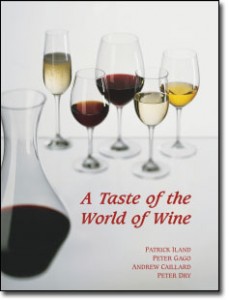A taste of the world of wine, Patrick Iland, Peter Gago, Andrew Caillard, Peter Dry
| Title of book: | A taste of the world of wine |
| Author: | Patrick Iland, Peter Gago, Andrew Caillard, Peter Dry |
| Publisher: | Patrick Iland Wine Promotions |
| Publication date: | 2009 |
| ISBN | 978 0 9581605 3 7 |
| Pages: | 209 |
| Price: | £59 Ex-publisher: AUD$59 (Australia) or AUD$54.50 plus P+P (outside Australia) |
 Pun fully intended, this book offers a taster, as in an introduction, to the wine world, and the erudition of these four authors augurs well for an enjoyable and edifying read. And wonderfully edifying it is. The authors do a great job of bringing flavour alive on the written page, if such a thing is possible. But don’t be seduced into imagining ‘introduction’ means coffee table book – there is no dumbing-down in this book, which is so much an all-in-one serious educational reference book.
Pun fully intended, this book offers a taster, as in an introduction, to the wine world, and the erudition of these four authors augurs well for an enjoyable and edifying read. And wonderfully edifying it is. The authors do a great job of bringing flavour alive on the written page, if such a thing is possible. But don’t be seduced into imagining ‘introduction’ means coffee table book – there is no dumbing-down in this book, which is so much an all-in-one serious educational reference book.
Anyone wanting to cram on wine information could do well to read and inwardly digest this. Indeed there is information a-plenty in here for the non-novice, for example the section on ‘in-mouth’ textures and sensations brings together succinctly in one place, and explains, many of the terms used often to describe non-flavour aspects of wine – roundness, richness, tightness, texture.
The book starts with chapters on the story of wine, and vines and grapes, putting wine in context of the fermented beverage about which the thrust of the book concentrates. This section neatly accesses much of the terminology of the wine world, getting the reader quickly up to speed with the language of wine.
As well as giving an engaging introduction to wine, the book introduces current themes such as regionality versus inter-regional blending, closure choices, the trend for grape varieties other than the ‘big six’ so-called international varieties, and wine and health. It finishes with a look at the food and wine pairing trend: matching or contrasting; power and weight.
Plentiful maps and pictures animate the world of wine and the diversity of vineyard environments around the world. These are complemented with easy to follow charts and flow diagrams to sum up otherwise complex information, especially in the main part of the book which details production, location, styles and flavours of the various categories of wine: sparkling, dry white, sweet white, red and fortified. Varieties are placed diagrammatically along the spectrum from light to full bodied, and snapshot boxes of flavour are there to help the reader pinpoint the sight, smell and taste summary for the main grape varieties.
While taking a global approach, the faintest Aussie slant to the perspective is to be expected, though one of the very few points for which I offer a Euro-perspective is that EU definitions of dryness levels differ marginally from the Aussie one. For example, EU dry white and red wines normally come in at less than 4g/l sugar (with exceptions). And classic dry reds in Europe are likely to be fully dry, that is, with less than 2g/l of sugar. Another notable point of difference is that a ‘standard drink’ of 10 grams of ethanol is Australo-centric. Across the world units vary by country between 8 and 14g of ethanol. But these points affect just two paragraphs of an excellent resource.



